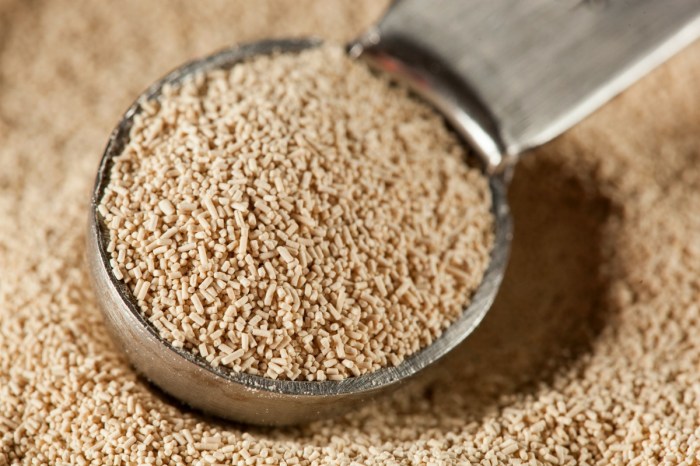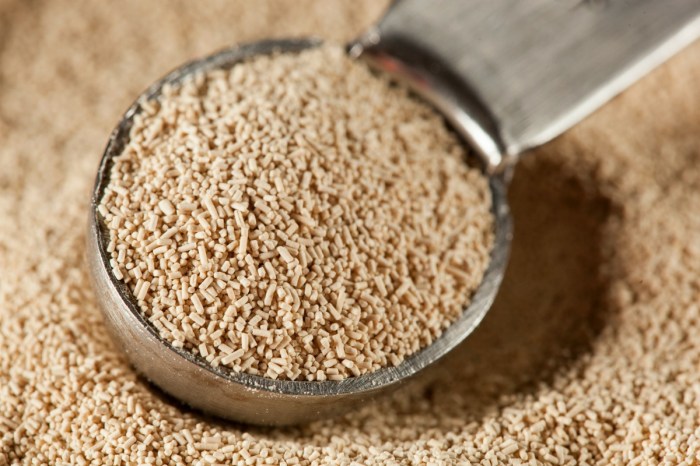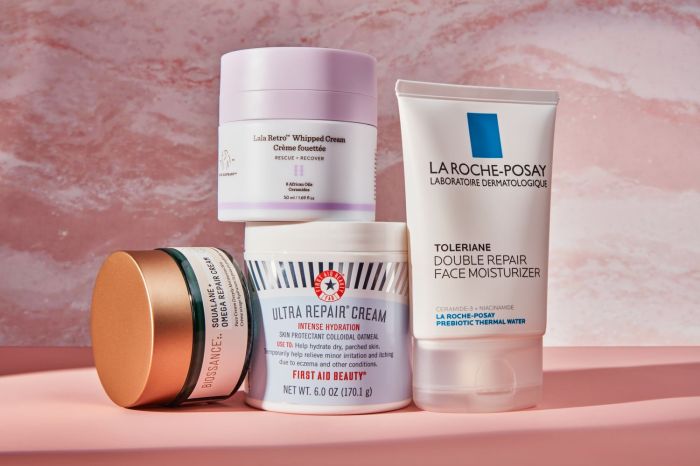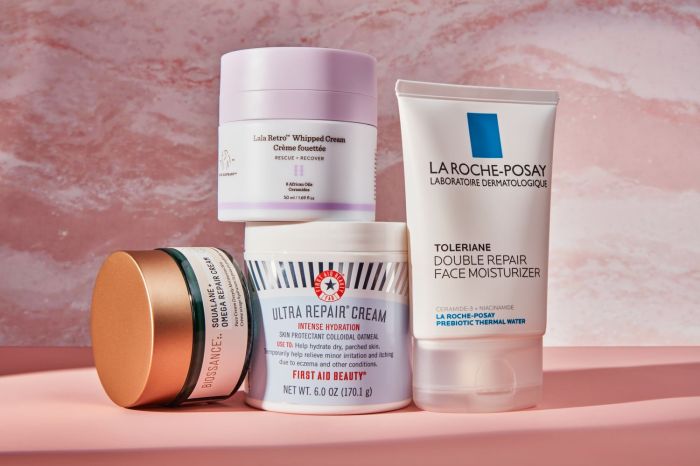Coping with dry cracked feet can be a frustrating experience, but with the right knowledge and care, you can effectively manage and prevent these unsightly and sometimes painful issues. This guide delves into the various causes, from lifestyle choices to underlying medical conditions, offering practical home remedies, professional treatments, and essential foot care practices to keep your feet healthy and happy.
We’ll explore everything from the importance of proper hydration and diet to choosing the right footwear and understanding environmental factors. Prepare to discover the secrets to preventing and treating dry, cracked feet, so you can walk confidently and comfortably.
Causes of Dry, Cracked Feet
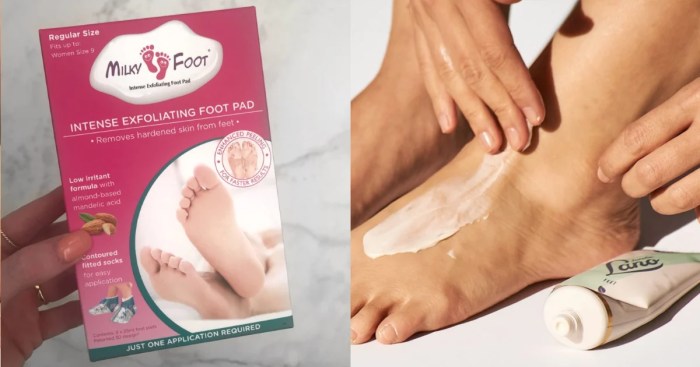
Dry, cracked feet are a common ailment, often stemming from a combination of factors. Understanding the root causes is crucial for effective prevention and treatment. Ignoring these underlying issues can lead to persistent discomfort and potentially more serious complications. Addressing the specific causes can lead to significant improvements in foot health.
Lifestyle Factors
Various lifestyle choices significantly impact foot health. Diet, hydration, and footwear all play a role in the development of dry, cracked feet. Poor circulation, resulting from inactivity or prolonged standing, can also contribute.
| Cause | Explanation | Prevention Strategies |
|---|---|---|
| Dehydration | Insufficient water intake leads to dry skin, including on the feet. Reduced moisture content makes skin more susceptible to cracking. | Increase daily water intake. Aim for at least 8 glasses of water per day. Consume hydrating foods like fruits and vegetables. |
| Poor Diet | A diet lacking essential vitamins and minerals, particularly vitamin E and fatty acids, can lead to dry, flaky skin. This deficiency weakens the skin’s protective barrier. | Include foods rich in vitamins and minerals. Focus on fruits, vegetables, lean proteins, and healthy fats. Consider a multivitamin if dietary intake is insufficient. |
| Lack of Moisture | Insufficient moisturizing of the feet, especially after washing, allows moisture to evaporate, leaving skin dry and prone to cracking. | Apply moisturizer regularly, especially after showering or bathing. Use a thick, hydrating cream or ointment. |
| Prolonged Standing or Sitting | Prolonged periods of standing or sitting can restrict blood flow to the feet, potentially leading to dryness and cracking. | Take regular breaks to move your feet and improve circulation. Wear supportive footwear to reduce pressure on the feet. Elevate your feet when possible. |
| Inappropriate Footwear | Tight, ill-fitting shoes or footwear lacking adequate support can cause friction and pressure on the feet, leading to dryness and cracks. | Wear well-fitting shoes that provide adequate support and cushioning. Avoid shoes that are too tight or too loose. Choose footwear appropriate for the activity. |
Medical Conditions
Certain medical conditions can exacerbate dryness and cracking. Diabetes, eczema, and psoriasis can all contribute to the issue. Additionally, some medications can have a drying effect on the skin.
| Cause | Explanation | Prevention Strategies |
|---|---|---|
| Diabetes | Diabetes can impair nerve function and blood flow to the feet, leading to decreased moisture and increased susceptibility to cracks. Poorly controlled blood sugar levels can further contribute. | Maintain good blood sugar control through diet, exercise, and medication. Check your feet regularly for any signs of dryness, cracks, or sores. Consult a podiatrist for appropriate foot care. |
| Eczema | Eczema, a chronic skin condition, can cause inflammation and dryness, leading to cracking and discomfort. | Consult a dermatologist for diagnosis and treatment. Follow their recommended skin care routine, including moisturizing. |
| Psoriasis | Psoriasis, another chronic skin condition, can result in dry, flaky skin that is more prone to cracking. | Consult a dermatologist for diagnosis and treatment. Follow their recommended skin care routine, including moisturizing. |
| Certain Medications | Some medications, such as diuretics, can have a drying effect on the skin, leading to dry, cracked feet. | Consult a doctor about potential side effects of medications. Discuss alternative options with your physician if possible. |
Environmental Influences
Environmental factors such as climate and exposure to harsh elements can impact foot health. Prolonged exposure to extremely dry or cold conditions can lead to dry, cracked skin.
| Cause | Explanation | Prevention Strategies |
|---|---|---|
| Dry Climate | Areas with low humidity often lead to dry skin, including on the feet. This can be exacerbated by central heating in homes. | Use a humidifier in your home, particularly during dry seasons. Ensure adequate moisture in the air. |
| Cold Weather | Cold weather can strip the skin of moisture, leading to dryness and cracking. | Wear warm, waterproof socks and shoes in cold weather. Apply moisturizer frequently. |
Home Remedies and Treatments
Dry, cracked feet can be a frustrating and uncomfortable issue, but thankfully, many effective home remedies can help alleviate the problem. These remedies often use readily available ingredients and can be a more affordable and accessible option compared to professional treatments. Understanding the potential benefits and drawbacks of each method is crucial for choosing the most suitable approach for your specific needs.
Effective Home Remedies
Various home remedies can effectively treat dry, cracked feet, often focusing on moisturizing and soothing the affected skin. These methods aim to improve skin hydration and reduce inflammation, leading to quicker healing and relief from discomfort. Consistency is key to achieving noticeable results.
- Moisturizing with Oils and Creams: Regular application of moisturizing creams or oils like coconut oil, shea butter, or olive oil can significantly improve skin hydration. These oils and creams help lock in moisture, preventing further dryness and promoting healing. The fatty acids in these oils can also nourish the skin, making it stronger and more resilient. Expected outcomes include softer, smoother skin and reduced cracking within a few weeks of consistent use.
However, some individuals may experience allergic reactions or skin irritation with certain oils, so it’s essential to test a small area first before applying to the entire foot.
- Foot Soaks: Soaking feet in warm water with added ingredients like Epsom salts, oatmeal, or honey can soften the skin and reduce inflammation. Epsom salts, for example, are known for their ability to draw out toxins and promote relaxation. Oatmeal can soothe irritated skin. Honey is a natural humectant, drawing moisture into the skin. The expected outcome is softened skin, reduced cracking, and reduced inflammation.
The drawback is that some people may experience skin irritation or allergic reactions to certain ingredients in the foot soak.
- Exfoliation: Gentle exfoliation can remove dead skin cells, revealing smoother, healthier skin underneath. This process allows moisturizing treatments to penetrate deeper and work more effectively. Use a soft brush or a pumice stone to gently exfoliate the affected areas. Be cautious not to over-exfoliate, as this can irritate the skin further. The expected outcome is smoother, softer skin and better absorption of moisturizers.
Over-exfoliation can cause further dryness and cracking.
- Using Honey: Honey has excellent moisturizing properties, which can be beneficial for dry and cracked feet. Its humectant properties help to draw moisture into the skin, making it softer and more supple. Applying honey directly to the affected area, and then covering it with a bandage can promote healing and reduce inflammation. Expect soft, moisturized skin. Allergic reactions to honey are possible.
Comparative Analysis of Home Remedies
| Remedy | Effectiveness | Safety | Cost-Effectiveness |
|---|---|---|---|
| Moisturizing with Oils and Creams | High (if consistent); varies depending on individual skin type and product | Generally high; potential for allergic reactions | High; readily available, affordable ingredients |
| Foot Soaks | Moderate to high (depending on ingredients); varies by individual | Generally high; potential for allergic reactions to specific ingredients | High; ingredients are often inexpensive |
| Exfoliation | Moderate; helps to prepare the skin for moisturizers | High (if gentle); potential for irritation with harsh exfoliants | High; often uses readily available materials |
| Using Honey | Moderate to high; depends on the consistency of use | Generally high; potential for allergic reactions | High; honey is often inexpensive |
Importance of Consistency
Consistency is crucial for any home remedy for dry, cracked feet. It takes time for the skin to heal, and regular application of chosen treatments is essential to see noticeable improvement. A single application may not yield immediate results. Just as a daily habit of brushing teeth is important for oral health, consistent application of these home remedies is necessary for skin health.
The healing process is gradual, and persistence is key to long-term success.
Professional Treatments

Dealing with severely dry and cracked feet can be frustrating. While home remedies often provide relief for mild cases, more serious situations may require professional intervention. Professional treatments offer targeted solutions for deeper issues and can significantly improve the condition of the skin.Professional treatments address the underlying causes of severe dryness and cracking, going beyond the surface-level care of home remedies.
These approaches often involve specialized techniques and products, potentially providing faster and more effective results. It’s crucial to understand the various options available and to discuss them with a healthcare professional to determine the most suitable course of action.
Specific Procedures
Professional treatments for severe foot dryness and cracking encompass a range of procedures designed to address the specific needs of each individual. These procedures often involve the use of specialized tools and techniques to soften and rejuvenate the skin. They can include topical treatments, such as prescription-strength moisturizers and keratolytics, as well as more intensive procedures.
Comparison of Professional Treatments
Different professional treatments for severe foot conditions vary in their approach, duration, and potential side effects. Some focus on moisturizing and softening the skin, while others target the underlying causes of dryness. A critical factor is the severity of the condition and the patient’s individual needs.
Table of Professional Treatments
| Treatment | Duration | Potential Side Effects |
|---|---|---|
| Prescription-strength moisturizers | Variable, depending on the severity and response; typically several weeks | Potential for mild skin irritation, redness, or dryness if not used correctly; allergic reactions are possible. |
| Chemical peels | A single session, but follow-up treatments might be necessary; varying durations based on severity and treatment type. | Temporary redness, swelling, and discomfort; potential for skin discoloration or infection if not performed by a qualified professional. |
| Keratolytic agents | Variable, depending on the product and severity of the condition; typically several weeks. | Potential for skin irritation, redness, and burning; potential for allergic reactions; careful monitoring is essential. |
| Exfoliation procedures | Single or multiple sessions; duration varies based on the specific procedure. | Possible mild to moderate discomfort, redness, and swelling; increased risk of skin infection if not performed by a trained professional. |
| Dermabrasion | Single or multiple sessions, depending on the severity; sessions may take hours. | Significant discomfort and swelling; potential for scarring, skin discoloration, and infection if performed improperly. |
Importance of Consulting a Healthcare Professional
It is essential to consult a healthcare professional before undergoing any professional treatment for severe dry, cracked feet. A qualified dermatologist or podiatrist can accurately diagnose the underlying cause of the condition and recommend the most appropriate treatment plan. They can assess the severity of the condition and tailor a treatment approach to minimize risks and maximize results.
Improperly addressing severe cases can potentially worsen the condition or lead to complications.
Foot Care Practices
Taking proactive steps to maintain healthy feet is crucial for preventing dry, cracked skin. Regular care, encompassing moisturizing, exfoliation, and protective measures, significantly reduces the risk of developing these issues. By incorporating these practices into your daily routine, you can safeguard your feet from dryness and promote overall foot health.Daily foot care isn’t just about avoiding cracked heels; it’s about promoting comfort, preventing infections, and maintaining the structural integrity of your feet.
Addressing dryness proactively prevents more serious problems from arising.
Moisturizing
Proper hydration is essential for maintaining healthy, supple skin on your feet. Dry skin is prone to cracking, and moisturizing helps to retain moisture, creating a protective barrier against environmental factors. Use a dedicated foot cream or lotion formulated for dry skin. Apply generously after washing and drying your feet, particularly after bathing or showering when skin is most absorbent.
Focus on areas prone to dryness, such as heels and the soles. Consistent application is key to achieving and maintaining healthy foot moisture.
Dealing with dry, cracked feet can be a real pain, right? Finding the perfect solution often involves a bit of trial and error. While I’m not a doctor, I’ve heard that some antibiotics, like amoxicillin, can take a while to kick in. For example, how quickly amoxicillin starts working depends on the infection and individual factors.
So, whether it’s a moisturizing cream, a soothing foot soak, or something else entirely, keep experimenting until you find what works best for your dry feet!
Exfoliating
Dead skin cells can accumulate on the feet, contributing to dryness and the formation of cracks. Regular exfoliation removes these cells, allowing moisture to penetrate deeper and promoting smoother, healthier skin. Use a foot scrub or a pumice stone to gently remove dead skin. Be mindful not to scrub too vigorously, as this can irritate the skin.
Exfoliate once or twice a week, depending on your skin’s needs. This practice helps maintain a healthy skin turnover cycle.
Protecting Feet, Coping with dry cracked feet
Protecting your feet from environmental stressors, such as harsh soaps, chemicals, and prolonged exposure to dry conditions, is vital for maintaining their health. Choose gentle soaps and avoid prolonged exposure to hot water, which can further dry out your skin. Wearing appropriate footwear, particularly in dry climates or when exposed to harsh weather, is crucial. Consider using socks made of breathable materials to absorb moisture and protect your feet from excessive friction or rubbing.
This protection prevents unnecessary trauma to your feet.
Step-by-Step Guide for Healthy Feet
- Cleanse: Wash your feet daily with lukewarm water and a gentle, non-irritating soap. Avoid using harsh soaps or hot water, which can dry out your skin.
- Dry Thoroughly: Pat your feet dry, paying special attention to the spaces between your toes. Moisture trapped in these areas can lead to fungal infections.
- Moisturize: Apply a thick layer of foot cream or lotion to your feet, focusing on areas like heels and soles. Repeat this application several times a day, especially after bathing or showering.
- Exfoliate: Gently exfoliate your feet once or twice a week using a pumice stone or foot scrub to remove dead skin cells. Avoid excessive scrubbing.
- Protect: Wear appropriate footwear to protect your feet from environmental elements and excessive friction. Choose breathable materials to maintain good foot hygiene.
- Inspect: Regularly inspect your feet for any signs of dryness, cracking, or other abnormalities. Early detection allows for prompt treatment.
Essential Foot Care Tips
- Use a humidifier in dry climates to increase moisture in the air.
- Avoid walking barefoot on surfaces that may be harsh or dry.
- Wear socks made of breathable materials to absorb moisture and protect your feet.
- Choose appropriate footwear that fits well and provides support.
- Consider using a foot soak with warm water and Epsom salts to soften your skin before moisturizing.
- Seek professional help if dryness or cracking becomes severe or persistent.
Dietary Considerations
A healthy diet plays a crucial role in maintaining overall well-being, and this extends to foot health. Nourishing your body with the right vitamins and minerals supports the structural integrity of your skin, helping prevent dryness and cracking. Understanding how specific dietary deficiencies can contribute to this issue can empower you to make informed choices for better foot care.A balanced diet rich in essential nutrients is vital for healthy skin, including the skin on your feet.
Dietary deficiencies can manifest in various ways, including dry, cracked, and irritated skin. Addressing these deficiencies can often lead to significant improvements in foot health, making dietary changes a valuable part of a comprehensive foot care routine.
Vitamins and Minerals for Healthy Feet
A balanced diet rich in vitamins and minerals is fundamental for healthy skin and overall foot health. These nutrients contribute to the structural integrity and moisture retention of skin cells.
- Vitamin E: This antioxidant is crucial for protecting skin cells from damage and promoting cell regeneration. It helps maintain skin elasticity and prevents dryness. Foods like nuts, seeds, spinach, and vegetable oils are excellent sources of vitamin E.
- Vitamin C: Essential for collagen production, vitamin C strengthens skin tissue and improves its elasticity. Citrus fruits, berries, and bell peppers are rich in this vital nutrient.
- Biotin: This B vitamin plays a key role in maintaining healthy skin and nails. It supports cell growth and regeneration, which can contribute to preventing dry, cracked skin on the feet. Foods such as eggs, nuts, and sweet potatoes are good sources of biotin.
- Zinc: This mineral supports skin healing and barrier function. Zinc deficiency can lead to skin dryness and impaired wound healing. Oysters, red meat, and beans are excellent sources of zinc.
- Omega-3 Fatty Acids: These essential fats are important for maintaining skin hydration. Cold-water fish like salmon and tuna are excellent sources of omega-3s. Plant-based sources include flaxseeds and chia seeds.
Dietary Deficiencies and Dry Feet
Certain dietary deficiencies can contribute to dry, cracked feet. A lack of essential vitamins and minerals can weaken the skin’s natural barrier function, making it more susceptible to dryness and cracking.
- Vitamin A deficiency: Vitamin A is essential for maintaining healthy skin. A deficiency can lead to dry, rough skin, including on the feet. Good sources of vitamin A include carrots, sweet potatoes, and leafy green vegetables.
- Vitamin D deficiency: While not directly associated with skin health, vitamin D plays a role in calcium absorption, which is important for maintaining bone health. Indirectly, adequate vitamin D intake can contribute to overall health, which in turn can support skin health.
- Iron deficiency: Iron deficiency can affect oxygen transport throughout the body, potentially impacting skin health and leading to dryness and cracking. Red meat, poultry, and leafy green vegetables are good sources of iron.
Foods for Healthy Skin and Feet
Consuming a variety of foods rich in vitamins, minerals, and healthy fats is key to maintaining healthy skin and preventing dry, cracked feet. This comprehensive approach ensures your body receives the necessary nutrients for optimal function.
- Fruits and Vegetables: Fruits and vegetables provide essential vitamins, minerals, and antioxidants that support skin health.
- Lean Protein Sources: Lean protein sources provide essential amino acids for skin cell growth and repair.
- Healthy Fats: Including sources of healthy fats, such as avocados, nuts, and seeds, helps maintain skin moisture.
Hydration and Foot Health
Adequate hydration is essential for maintaining healthy skin and overall well-being, including foot health. Drinking sufficient water helps keep skin cells hydrated, preventing dryness and cracking.
- Water Intake: Drinking plenty of water is crucial for maintaining healthy skin and preventing dryness. Aim for at least eight glasses of water per day.
- Hydrating Foods: Foods with high water content, like fruits and vegetables, contribute to overall hydration. These foods can be incorporated into your diet to support your daily fluid intake.
Footwear and Environmental Factors
Our feet, often hidden and neglected, play a crucial role in our overall well-being. Proper foot care extends beyond moisturizing and exfoliating; understanding the impact of footwear and environmental conditions is equally important in maintaining healthy, happy feet. Ignoring these aspects can lead to a cascade of issues, including dry, cracked skin, which can be uncomfortable and even painful.Footwear choices significantly influence foot health.
The right fit and material can prevent friction and pressure points, while the wrong ones can lead to blisters, calluses, and ultimately, dry, cracked skin. Understanding these connections is essential for maintaining healthy feet.
Impact of Footwear Choices
Proper footwear selection is essential for preventing foot problems. Shoes that fit correctly and are made from breathable materials allow your feet to breathe and prevent excessive moisture buildup, reducing the risk of dryness and cracking. Conversely, ill-fitting shoes can cause friction, leading to blisters and calluses. These irritated areas are more susceptible to dryness and cracking.
- Proper Fit: Shoes that are too tight or too loose can cause rubbing and friction. A proper fit allows your toes to have adequate space, preventing pressure points and blisters. Always try shoes on at the end of the day, when your feet are at their largest.
- Material Matters: Breathable materials like leather or mesh allow your feet to breathe, preventing excessive moisture buildup and keeping the skin dry. Synthetic materials, while sometimes affordable, can trap moisture, leading to skin issues. Consider the material’s breathability when selecting footwear.
Environmental Factors
Harsh environmental conditions can significantly exacerbate dry, cracked feet. Prolonged exposure to cold, dry air or hot, humid environments can both negatively impact foot health. Understanding these environmental triggers is crucial for proactive foot care.
- Extreme Temperatures: Exposure to extremely cold temperatures can dry out the skin, making it more prone to cracking. Conversely, excessively hot and humid environments can lead to sweating and fungal infections, which can also contribute to dryness and cracking. Protecting your feet from these extremes is crucial. Wearing appropriate footwear, such as waterproof boots in winter or moisture-wicking socks in humid conditions, can help prevent these problems.
- Harsh Weather Conditions: Winter’s cold, dry air and summer’s humidity can significantly affect your feet. Wind and snow can strip the skin of its natural oils, while excessive heat and humidity can lead to increased perspiration. Pay close attention to foot care during these periods, choosing footwear and clothing that protect your feet from the elements. For instance, wearing waterproof boots during snowy weather or using moisture-wicking socks during hot, humid days can significantly mitigate these issues.
- Foot Hygiene and Environment: Maintaining good foot hygiene is crucial, regardless of the environment. Washing your feet regularly, drying them thoroughly, and using foot powder or talcum powder can help prevent fungal infections and excessive moisture buildup, which are major contributors to dry, cracked feet. Pay special attention to foot hygiene when spending time in humid or wet environments, such as swimming pools or during prolonged outdoor activities in the rain.
Protecting Feet from Extreme Temperatures
Protecting your feet from extreme temperatures is crucial for preventing dry, cracked skin. The right footwear can shield your feet from the elements, and proper care can maintain foot health in all seasons.
- Winter Protection: Waterproof and insulated boots can protect your feet from the cold, dry air of winter. Avoid wearing synthetic materials, as these can trap moisture. Ensure boots are a snug fit, but not overly tight.
- Summer Protection: Breathable, lightweight shoes are essential in the summer to prevent overheating and excessive sweating. Moisture-wicking socks are recommended to absorb sweat and maintain dry feet.
Prevention Strategies: Coping With Dry Cracked Feet
Keeping your feet healthy and preventing dry, cracked skin is crucial for overall foot well-being. Proactive measures are key to maintaining soft, supple skin and avoiding the discomfort of dry, cracked feet. A combination of consistent habits and mindful choices can significantly reduce the risk of this common problem.Effective prevention involves understanding the contributing factors and implementing strategies to combat them.
This includes paying attention to environmental conditions, footwear choices, and your overall lifestyle. By implementing the preventative measures Artikeld below, you can significantly improve the health and appearance of your feet.
Dealing with dry, cracked feet can be a real drag, but it’s totally manageable! Just like how you might want to tackle those pesky wrinkles, you need a consistent routine. Applying a good moisturizer, like a thick cream, and wearing socks at night can make a huge difference. For more tips on how to get rid of wrinkles, check out this great resource: how to get rid of wrinkles.
Ultimately, keeping your feet hydrated is key to preventing and treating those dry, cracked areas, so don’t underestimate the power of regular foot care!
Daily Foot Care Routine
A consistent daily foot care routine is essential for maintaining healthy foot moisture. Regular cleansing and moisturizing are vital steps in this process. Proper foot care practices contribute significantly to preventing dryness and cracking.
- Thorough Cleansing: Clean your feet daily with lukewarm water and a gentle, non-abrasive soap. Avoid using harsh soaps or scrubbing vigorously, as this can irritate and dry out the skin. Pay close attention to the areas between your toes, ensuring they are thoroughly cleansed.
- Gentle Drying: After washing, pat your feet dry gently, especially between the toes. This helps prevent moisture buildup, a key factor in preventing fungal infections and promoting healthy skin.
- Moisturizing: Apply a moisturizing cream or lotion to your feet, focusing on dry or cracked areas. This helps replenish lost moisture, keeping the skin hydrated and supple. Apply moisturizer immediately after washing your feet, while the skin is still damp.
Footwear Selection
Appropriate footwear plays a critical role in preventing dry, cracked feet. The right shoes offer support, protection, and prevent excessive friction that can lead to dryness. Consider the material, fit, and design when choosing your footwear.
Dealing with dry, cracked feet can be a real drag, but thankfully, there are ways to soothe them. Just like when you’re recovering from a cold, noticing subtle improvements can be a good sign that you’re on the right track to healing. For example, if you’re noticing your sniffles are lessening or your cough is becoming less frequent, you’re likely experiencing some of the signs your cold is getting better.
Similarly, if you’re noticing your feet are less dry and the cracks are starting to heal, you’re well on your way to having happy, healthy feet again. Keep up the good foot care routine, and you’ll be back to feeling great in no time.
- Proper Fit: Ensure your shoes fit comfortably and don’t put excessive pressure on your feet, especially in the toes and heels. Avoid shoes that are too tight or too loose. Properly fitting shoes help prevent friction and blisters, reducing the risk of cracked skin.
- Material Considerations: Choose breathable materials for your shoes, such as leather or mesh. These materials allow air circulation, preventing moisture buildup and reducing the risk of dryness. Avoid shoes made of synthetic materials that trap moisture.
- Appropriate Footwear for Activities: Select footwear appropriate for the activity. For example, supportive shoes are crucial for activities that put a lot of stress on your feet, like walking or running. This reduces friction and strain on the skin.
Environmental Considerations
Environmental factors significantly influence foot health. Maintaining a suitable environment for your feet can contribute to preventing dryness.
- Climate Control: In dry climates, consider using a humidifier to add moisture to the air. This helps maintain a healthy moisture level, reducing dryness in the surrounding environment and on your skin.
- Foot Protection in Harsh Conditions: In cold or very dry weather, protect your feet from extreme temperatures. Wearing warm socks in cold weather and waterproof footwear in wet conditions are crucial.
Foot Health Checklist
Regularly checking your feet for signs of dryness, cracking, or other issues is a proactive measure. A consistent foot health check-up helps you identify potential problems early.
| Check Point | Action |
|---|---|
| Inspect for cracks and dryness | Examine the soles, heels, and areas between the toes. |
| Assess for redness or inflammation | Look for signs of irritation or infection. |
| Check for calluses or corns | Inspect for areas of thickened skin. |
| Feel for temperature changes | Notice any unusually warm or cold spots. |
| Assess for any pain or discomfort | Identify any areas causing pain or discomfort. |
Visual Aids and Illustrations
Seeing is believing, and understanding the visual aspects of dry, cracked feet is crucial for effective self-care. Visual cues can pinpoint the specific issue and guide you towards the most suitable treatment. Visualizing the various foot conditions, footwear types, and home remedies can greatly enhance your ability to identify and address foot problems.Visual representations of foot conditions, footwear, and home remedies can significantly aid in understanding and managing foot care.
By observing images and descriptions of different conditions and their varying degrees of severity, you can accurately assess your own feet and take appropriate action.
Foot Condition Visualizations
Visualizing foot conditions is essential for accurate diagnosis and treatment. Different conditions manifest with varying appearances, textures, and severities.
- Dry, Cracked Skin: This condition often presents as flaky, rough patches of skin, particularly on the heels and soles. The skin may appear dull and lack its usual suppleness. Cracks can vary in depth, ranging from minor fissures to deeper, painful ones. The severity is usually correlated with the level of dryness and lack of moisture.
- Fissures: These are deep, often painful cracks in the skin. Fissures can run along the soles or sides of the feet, sometimes extending into the deeper layers of skin. The depth of the fissure directly impacts the level of discomfort. In severe cases, fissures can bleed and become infected.
- Calluses: Calluses are thickened areas of skin that develop in response to pressure or friction. They appear as hard, rough, and often raised patches on the feet. Calluses typically occur on the soles, heels, or areas of the feet that bear the most weight. Their size and thickness depend on the level of friction and pressure.
Footwear and Impact on Foot Health
Choosing the right footwear is critical for maintaining healthy feet. The materials, fit, and support of shoes greatly influence foot health.
- Materials: Leather, synthetic materials, and breathable fabrics all impact the foot’s environment. Leather allows for better air circulation, but synthetics can be more durable. Materials that wick moisture away from the skin are beneficial for preventing moisture buildup, a common cause of foot problems.
- Fit: Properly fitting shoes are essential. Shoes that are too tight can cause pressure points, blisters, and calluses, while shoes that are too loose can lead to instability and increased risk of injury. A proper fit should allow for comfortable movement without restricting toes or causing rubbing.
- Support: Good arch support is crucial for maintaining the natural alignment of the foot. Shoes with adequate arch support can help reduce strain on the feet and prevent foot pain. Consider the type of activity you’ll be doing when choosing shoes with appropriate support. For example, supportive shoes are essential for long-distance walking or standing.
Home Remedies and Application
Home remedies are often the first line of defense against dry, cracked feet. Applying moisturizers and oils effectively rehydrates the skin and soothes dryness.
- Moisturizers: Applying moisturizers regularly can effectively hydrate the skin, improving dryness and preventing cracking. Choose a moisturizer that suits your skin type and that contains ingredients known for their moisturizing properties. Moisturizers should be applied to damp skin to ensure better absorption. Repeated applications are necessary for optimal results.
- Oils: Natural oils like coconut oil, olive oil, or almond oil can effectively hydrate and soften the skin. Massage these oils into the affected areas to promote absorption. These oils can help repair damaged skin cells, promoting healthy foot skin.
Epilogue
In conclusion, managing dry, cracked feet requires a multifaceted approach encompassing lifestyle adjustments, home remedies, professional treatments, and preventative measures. By understanding the root causes, implementing effective home care, and seeking professional help when needed, you can significantly improve your foot health and reclaim comfort and confidence. Remember, consistency is key to achieving lasting results, and with the right strategies, you can bid farewell to dry, cracked feet and embrace healthy, happy feet.

